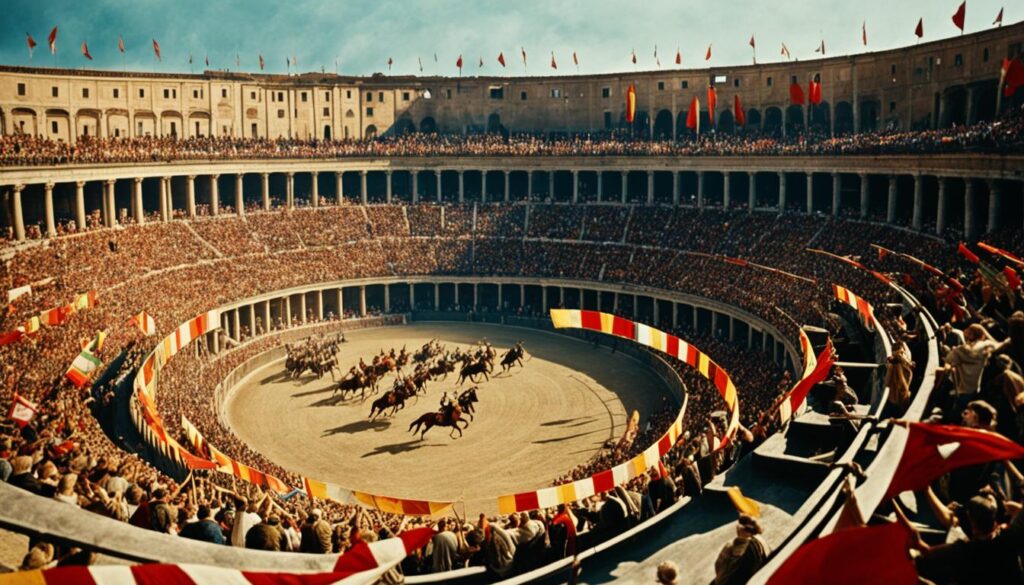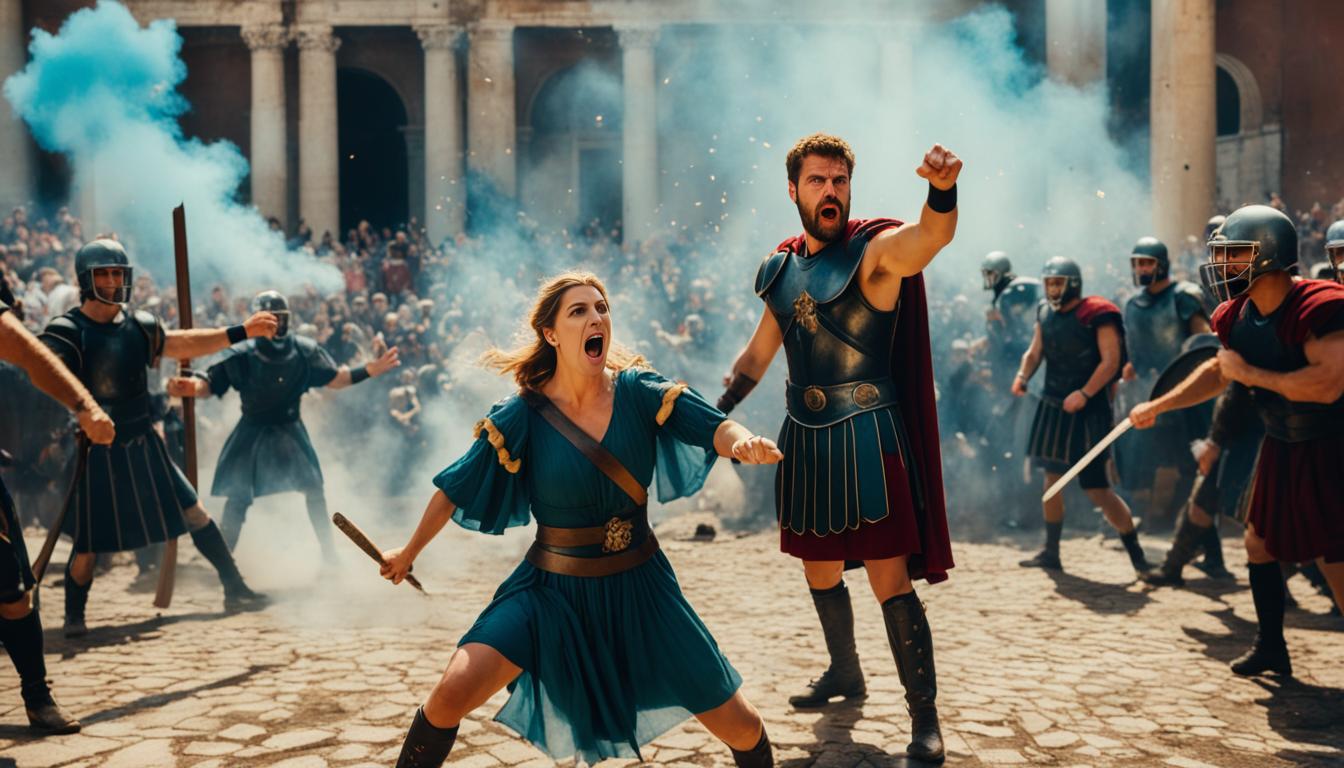In 532 CE, Roman Emperor Justinian I faced an unexpected revolt. The Nika riots, sparked by passionate sports fans, nearly toppled his reign. Chariot racing factions, the Blues and Greens, ignited a five-day rebellion in Constantinople.
Multiple factors triggered the Nika riots. Recent tax hikes and arrested faction leaders fueled unrest. Tensions between chariot racing teams boiled over. Rioters united against Emperor Justinian I, demanding their imprisoned comrades’ release.
Justinian I and his wife Theodora faced a crucial choice. Should they flee or confront the rioters? Theodora reportedly convinced Justinian to stay and fight. She declared, “Purple makes a fine shroud,” referencing the imperial color.
The emperor rallied his forces and quelled the uprising. This action solidified his grip on power. The Nika riots showcase how sports passion can impact politics.
This incident reveals the complex relationship between entertainment and authority. It highlights how social unrest can challenge imperial power in the Roman Empire.
Key Takeaways
- The Nika riots were a violent uprising in Constantinople in 532 CE, instigated by rival chariot racing factions known as the Blues and the Greens.
- The riots were triggered by a combination of factors, including tax increases, the arrest of faction leaders, and the intense rivalry between the racing teams.
- Emperor Justinian I and his wife Theodora faced a critical decision during the riots: flee the city or confront the rioters head-on.
- Theodora reportedly convinced Justinian to stay and fight, leading to the suppression of the revolt and the solidification of imperial power.
- The Nika riots demonstrate how sports fandom and political unrest can intersect, highlighting the complex dynamics of popular entertainment and imperial authority in ancient Rome.
The Nika Riots: A Violent Uprising in Constantinople
In 532 CE, Constantinople faced a violent uprising called the Nika riots. These riots lasted nearly a week and targeted Emperor Justinian I. They destroyed half the city and killed thousands.
On January 13, 532, an angry crowd gathered at the Hippodrome for chariot races. They hurled insults at Justinian I, showing their discontent. As races continued, the crowd’s chants changed.
By race 22, everyone shouted “Nίκα” (Nika), meaning “Win!” or “Victory!” in Greek. United by this cry, rioters left the Hippodrome and attacked the imperial palace.
The palace was under siege for five days. Fires spread through Constantinople, destroying much of the city. Even the Hagia Sophia church burned down.
The Nika riots showed the power of popular unrest in Constantinople. They challenged Emperor Justinian I and his wife Theodora’s control. The riots also highlighted the role of chariot racing factions in politics.
The Role of Chariot Racing Factions in Roman Politics
In ancient Rome, demes supported different chariot racing factions. Four main factions existed, each with a unique color. By the 6th century, only the Blues and Greens held major sway.

Demes became hubs for social and political issues. They acted as outlets for Byzantine people who lacked other ways to express themselves. These groups mixed street gang and political party traits.
They voiced opinions on current events and theology. Between races, they shouted political demands to sway imperial policy. This showed how sports and politics intertwined in Roman society.
As factions grew stronger, they resembled modern political parties. The Blues and Greens dominated, often clashing violently in the streets. Emperors sought their support to maintain control over the people.
The factions’ power peaked during Emperor Justinian I’s reign. Blues and Greens played key roles in power struggles. Their support often decided political conflicts’ outcomes.
The Nika riots in Constantinople showed the demes’ immense power. This violent uprising challenged even the emperor’s authority. It proved how influential these racing factions had become in Roman politics.
Roman Emperor Sports Fan Revolt: Causes and Triggers
Justinian I’s reign sparked unrest, leading to the Roman Emperor Sports Fan Revolt. Several factors fueled public discontent, resulting in a violent uprising.
High tax rates imposed by Justinian and his officials angered the people. His advisors, John the Cappadocian and Tribonian, faced criticism for these burdensome policies.
Corruption allegations against John and Tribonian intensified public outrage. John’s harsh treatment of debtors upset senatorial elites affected by new taxation policies.
Justinian and John aimed to reduce civil service costs and fight corruption. These actions, though well-intentioned, may have contributed to growing unrest.
The chariot racing factions’ unchecked power under the previous emperor also played a role. Justinian’s support for a specific faction heightened rivalries, destabilizing Constantinople’s power balance.
These combined factors created a perfect storm of discontent. High taxes, corruption claims, and faction rivalries ultimately triggered the violent revolt against Justinian I.
Justinian I and Theodora: Facing the Rioters
The Nika riots in Constantinople put Emperor Justinian I in danger. Angry mobs set fires and fought imperial forces. Justinian thought about fleeing, but his wife Theodora urged him to stay.
Justinian ordered his generals to attack the Hippodrome where rioters gathered. Soldiers killed the crowd, while guards blocked exits. About 30,000 people died, nearly 10% of Constantinople’s population.
Justinian ruled for 33 more years after the riots. His legacy includes building projects, legal reforms, and military campaigns. Theodora’s intelligence and support helped Justinian overcome political challenges.
Theodora, a former actress, became one of Byzantine’s most influential women. Her wit and loyalty were crucial in helping Justinian face threats to his reign.

Leave a Reply